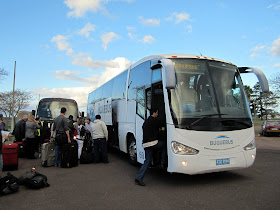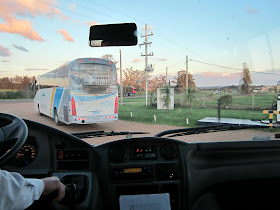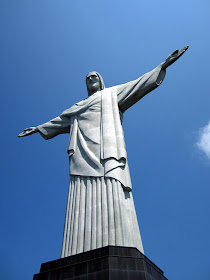Getting from Iguaçu to Uruguay was originally supposed to by an easy, time saving side trip. We would fly in on a direct Pluna flight to Montevideo, spend two days there and then take the ferry direct to Buenos Aires. All total, we would save $160 per person by avoiding the reciprocal fees at the Buenos Aires airports and check off another country. Easy, right?
Except then Pluna went bankrupt and was shut down and until the day before our flight we weren't 100% sure if we were leaving from the Brazilian or Argentine airport. Buquebus, the airline that we got our replacement tickets on (still to Montevideo), doesn't actually use airport codes on their website. We knew we left from the area, but which airport was something that only a local call to the airport could actually answer.
Security went smoothly and then into the boarding area. There are no services except for a small snack bar in the international area that we were in, so beware that once you start towards security you lose your ability to change money, which might be important if you have excess guarani. It is basically worthless outside of Paraguay (On that note, if you have a few nice guarani notes left over, I would be interested in them. Email me!) We headed over to our plane and proceeded to... wait.
We were there for about an hour plus after boarding and watched two planes land and one of them leave again. While we were waiting, people were in generally good spirits, except for one young child who was fussy over being hungry and thirsty. When the flight attendants offered some water and a cracker pack, some others started to pretend to whine as well, jokingly asking for "Papa fritas" (French fries) and "aqua con gas" (carbonated water). Despite the delay, people were at least having fun. We pushed back and were finally off to Salto, which was our first stop before heading to Montevideo.The flight had a little chop, but mainly below there were light fluffy clouds and green land underneath. Our in flight snack was pizza flavored crackers and small pouch of cookies.
Landing in Salto, I had a bad feeling. As we pulled up to the tiny airport, I noticed immediately that there was a bus waiting just on the other side of the fence. Once the plane had shut down, the captain came on the overhead and then the fun started: It was too windy in Montevideo to fly there and we would be taking a bus the rest of the way...
...for the next six hours.

The entire plane took it in stride. At most, people gave a low grown and then got ready. We figured it was bad news, but didn't really know what was going on. That is part of the adventure of travel, and sure enough we left the plane, went through security and got stamps in our passport and then headed off by bus. We stopped at a gas station, bought snacks for the trip, and settled in for the ride. Eventually we got to Montevideo just past midnight and found out why we couldn't fly there directly: They had been hit by a hurricane and everything had been shut down.
The 24 hour McDonald's at the main bus terminal? Closed. The other 24 hour McDonald's near our hotel? Closed. The city wasn't too badly damaged, but signs had been uprooted out of concrete, branches were everywhere, and in general people were pretty shocked that they had been hit by such a strong storm. At the very least, I can say that I was impressed with how quickly they recovered. Just the fact that they had a bus waiting for us at Salto was probably a sign that they had things pretty well organized, given the storm and the confusion that must have come with being hit by that.
Finally, after a long trip we settled into After Hotel (which was very nice with very helpful staff), and got ready to get up and head to Buenos Aires.





















































